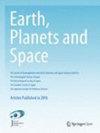Classification of the equatorial plasma bubbles using convolutional neural network and support vector machine techniques
IF 2.5
3区 地球科学
引用次数: 0
Abstract
Abstract Equatorial plasma bubble (EPB) is a phenomenon characterized by depletions in ionospheric plasma density being formed during post-sunset hours. The ionospheric irregularities can lead to disruptions in trans-ionospheric radio systems, navigation systems and satellite communications. Real-time detection and classification of EPBs are crucial for the space weather community. Since 2020, the Prachomklao radar station, a very high frequency (VHF) radar station, has been installed at Chumphon station (Geographic: 10.72° N, 99.73° E and Geomagnetic: 1.33° N) and started to produce radar images ever since. In this work, we propose two real-time plasma bubble detection systems based on support vector machine techniques. Two designs are made with the convolutional neural network (CNN) and singular value decomposition (SVD) used for feature extraction, the connected to the support vector machine (SVM) for EPB classification. The proposed models are trained using quick look (QL) plot images from the VHF radar system at the Chumphon station, Thailand, in 2017. The experimental results show that the combined CNN-SVM model, using the RBF kernel, achieves the highest accuracy of 93.08% while the model using the polynomial kernel achieved an accuracy of 92.14%. On the other hand, the combined SVD-SVM models yield the accuracies of 88.37% and 85.00% for RBF and polynomial kernels of SVM, respectively. Graphical Abstract利用卷积神经网络和支持向量机技术对赤道等离子体气泡进行分类
赤道等离子体泡(EPB)是一种以日落后电离层等离子体密度消耗为特征的现象。电离层的不规则性可能导致跨电离层无线电系统、导航系统和卫星通信中断。epb的实时探测和分类对空间气象界至关重要。自2020年以来,在Chumphon站(地理:10.72°N, 99.73°E,地磁:1.33°N)安装了甚高频(VHF)雷达站Prachomklao雷达站,并从此开始生成雷达图像。在这项工作中,我们提出了两种基于支持向量机技术的实时等离子体气泡检测系统。采用卷积神经网络(CNN)和奇异值分解(SVD)进行特征提取,并连接支持向量机(SVM)进行EPB分类。所提出的模型使用2017年泰国春蓬站VHF雷达系统的快速查看(QL)图图像进行训练。实验结果表明,使用RBF核的CNN-SVM联合模型准确率最高,达到93.08%,而使用多项式核的模型准确率最高,达到92.14%。另一方面,SVM -SVM组合模型对SVM的RBF和多项式核的准确率分别为88.37%和85.00%。图形抽象
本文章由计算机程序翻译,如有差异,请以英文原文为准。
求助全文
约1分钟内获得全文
求助全文
来源期刊

Earth, Planets and Space
地学天文-地球科学综合
CiteScore
5.80
自引率
16.70%
发文量
167
期刊介绍:
Earth, Planets and Space (EPS) covers scientific articles in Earth and Planetary Sciences, particularly geomagnetism, aeronomy, space science, seismology, volcanology, geodesy, and planetary science. EPS also welcomes articles in new and interdisciplinary subjects, including instrumentations. Only new and original contents will be accepted for publication.
 求助内容:
求助内容: 应助结果提醒方式:
应助结果提醒方式:


